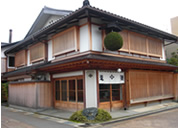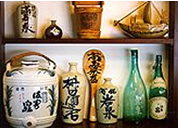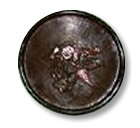- HOME
- History of Masudashuzo
East Iwase Prefecture

The streets that once flourished with trades by what was once called Kitamae-Bune (a ship locally named Bai-sen) still holds a remainder of its past flare in the houses of Kaisen-Donya and high-class restaurants called Ryotei. Masudashuzo is located in the heart of this historic place.
Founded in Asahikawa

The founder of Masudashuzo, Kamejiro, married Fude, who was a daughter of one of the most prominent Kaisen-Donya in Iwase prefecture. He used the ship Kitamae-Bune to found a Sake Manufacturing Company in the still developing land of Hokkaido, Asahikawa. It was around the 26th year in Meiji Period that we start seeing its first commercial name, 'Miyako-Matsu', in the history of Asahikawa. He met a tremendous success of 1500-Seki, which was impressive at that period, but 10 years after the founding of the company Fude suggested that they return to Iwase after a year of harsh blizzard. 2 years later, they returned to Iwase. Back in his old city, he started selling a brand called Iwaizumi, but in order for the Geisha in the ports to enjoy his brand, he established a newly named brand called 'Masuizumi', which was the most auspicious name to be derived from his surname, Masuda. Masuizumi was an immediate success, which still continues to be our main brand.
Ginjo-Masuizumi

40 years into the Showa Period, the company took a risk to delve into the brewing of Ginjo-Shu, which was still relatively unknown and unrecognized by the public market. The present head of the company pursued his study of fermentation into the graduate school, but after the sudden death of his father, he took over the company at the age of 22.
The young Toji named Kiichi showed a remarkable talent as the brewing team of the company, leaving results only after a few years excellent enough for gold awards by the Review Committee.
"I believe that Sake is made by yeast and malt, and people just make the environment that makes it easier for them to work", Kiichi says. "I think when you try to make everything hand-made, it may make it sound more traditional and romantic, but it's not necessarily good for the product". As practical as he sounds, when he redid the malting room 5 years ago, he went to Noto Prefecture with his staff to get the right cedar in order to build the room in a traditional fasion. They had trouble locating rice hulls and another material that they finished the room in the nick of time before the actual brewing began.
The manufacturing in Masuizumi begins every year on the Tai-an (ausupicious day in Buddhist calendar) on October.
After the cutting in the rice field is done, the staffs prepare for the winter and go into the manufacturing, including the Toji and 18 cooking staffs. Until the spring when the planting season begins, the staffs work continually throughout Sundays and even New Years. Until a couple of years ago it was hard to get a day off in this 6-months period, but now the staffs enjoy a 3-day holiday per month. Only the Toji, who entered this road when he was only 18, has never returned home in the New Year. His father, grandfather, and relatives are all Toji, and he inherited his father's place at Masuizumi. This family of elite Toji remained a close company to 5 generations of Masuda Family.
"The taste of Sake should change as the time goes by, and there is a right Sake that matches the taste of each generations. And of course we must enhance our technic for manufaturing everyday. I would like to pursue the study of great-tasting Sake more and more". Every successful person may have trouble ridding the past, but at the age of 72, this remarkable Toji is still ready to face new challenges.

